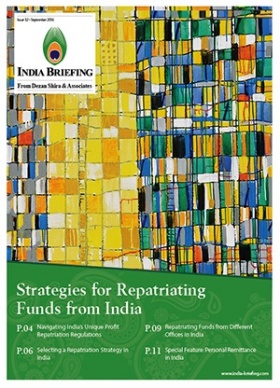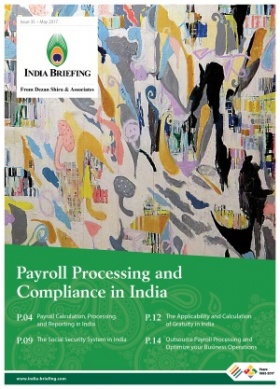Remitting Money from India – Choosing the Right Repatriation Strategy
By Dezan Shira & Associates
Funds can be repatriated from one country to another in various ways. The obvious implications are that such transactions entail foreign exchange risks, and companies also need to account for regulatory and tax risks.
Investors and companies should, therefore, note that choosing the right strategy to repatriate funds can reduce their tax burden and increase net profit. In turn, such cost savings make it possible for reinvesting in innovation and improving the productivity of the business.
This risk-reward calculus becomes more complex in India, which has a unique business environment.
To aid their assessment, the following sections will critically evaluate the repatriation strategies highlighted in the below graph.
Dividends
A foreign company that makes an equity contribution to its Indian subsidiary often demands dividend payouts. The payout may be annual or at a predetermined time interval and is usually a share of the profits that the Indian subsidiary has earned.
The Indian entity that is distributing profits through dividends is liable to pay tax. The tax, namely the Dividend Distribution Tax (DDT), is currently charged at 15 percent plus applicable surcharges and education cess. In terms of tax deductibility, dividends and DDT are not deductible expenses, as prescribed by Section 115-O(5) of the IT Act. In the event that an Indian company pays the dividends to a non-resident/foreign company, dividends do not create an obligation to withhold tax.
Dividends are mostly taxed in the country where the dividends are being received. It is important to note that a number of bilateral Double Tax Avoidance Agreements (DTAA) offer either tax credits or exempt foreign-sourced income from taxation.
In addition, the Companies Act, 2013, states that it is mandatory for a company to transfer a stipulated percentage of the profits to reserves prior to declaring and distributing dividends. The percentage generally ranges between 2.5 and 10 percent. Another risk that companies need to account for is foreign exchange risk. Under the Foreign Exchange Management Act (FEMA), dividends can be freely repatriated through the automatic route. However, preferential dividends are subject to some caps.
Under Section 2(22) of the IT Act, distribution from accumulated profits are treated as dividends. The remaining amount is deemed capital gains.
In terms of DTAAs, the DDT credits need to be examined. In addition, tax on capital gains can be applicable in either the source country or resident country, or be dependent on the specific DTAA that applies to each transaction.

Share buyback
A foreign company could return the shares that it owns on its Indian counterpart, and in turn, the Indian company would have to pay the consideration for the shares. Both companies generally decide on a pre-decided number of shares that will be sold at a pre-determined price based on internationally accepted valuation methods which are in compliance with Indian foreign exchange regulations. Once the shares are bought back, they are subsequently cancelled. Most companies that have surplus cash with no attractive investment routes use share buyback as a means to return the cash to their shareholders.
However, there is a withholding tax of 20 percent on distributed income at the time of buyback. Distributed income is the difference between the amount paid at the time of buyback and amount received by the company at the time of issue of shares.
DTAAs, in the event of share buybacks, operate diversely, and the tax liability depends on the specific tenets of each DTAA. Some examples are:
- Taxed in source country: India-New Zealand DTAA.
- Taxed in both, source and resident countries, with tax credits permitted: India-UK DTAA, India-Mauritius DTAA.
The Companies Act of 2013 also creates several regulatory obligations for companies that want to use share buybacks:
- The Articles of Association (AOA) for the Indian company should authorize share buybacks.
- Each buyback should be authorized through a special resolution passed at the general meeting of the respective company and completed within 12 months of any such resolution.
- A limit of 25 percent per financial year (FY) applies on equity share buyback. The consideration for such shares is capped at 25 percent of the total paid up capital plus free reserves per FY.
- In addition, no free securities should be issued for six months after a share buyback and the debt-to-equity ratio post buyback should be 2:1.
As per FEMA, pricing of shares should be as per internationally accepted pricing methodologies.
Capital reduction
The process of capital reduction entails another means of repatriating surplus cash. The method is generally used when a company wishes to repatriate cash and the amount crosses the permissible share buyback limits. It usually takes place at a pre-determined price. It is primarily a reduction of holding from the foreign company and the return of capital from the Indian company.
The Companies Act, 2013 states that approval is required from the shareholders (as a special resolution), creditors, and the state High Court for capital reduction. In addition, businesses should note that the number of shares and the amount of funds are not restricted for capital reduction. This is one of the key differences between capital reduction and share buybacks.
Under FEMA, the pricing of capital should adhere to RBI guidelines; no approvals are required for non-resident investors for capital reduction, so long as a few procedural compliances are ensured.
Royalties
If the Indian company uses a technology or process that is patented by the parent foreign company, then the Indian company is liable to pay royalties to the foreign company for using the foreign company’s intellectual property.
Commonly, Indian companies pay a royalty to either a holding company or the foreign owner company for technological collaboration. The payment is made for the right to use manufacturing processes, technical expertise, design, drawings, trademarks, and brand names.
Under the IT Act, the Indian company would need to withhold taxes at 10 percent plus any applicable surcharge and education cess. However, the payee should have a valid Personal Account Number (PAN) allocated by the IT department in India. The tax is calculated on a gross basis on the total royalty payments.
The Indian company can access tax breaks of around 30 percent; however, this is subject to the arm’s length criteria as defined under the IT Act, and must be verified by a chartered accountant. DTAAs generally prescribe the level of taxation for royalties. The taxes range from 10 to 15 percent.
Meanwhile, under FEMA, royalty payments are categorized as current account transactions and are permitted under the automatic route without any limits.
Payment for services
A foreign company can provide services that its Indian counterpart uses. In turn, the Indian company makes a payment for the services used. This payment could be made in several forms, including service fees.
Payments for services, such as management and consultancy fees or IT services from the foreign office, are often subject to different rules compared to royalties. The characteristics of the payment determine the level of taxation.
For instance, payments that qualify as Fee for Technical Services (FTS) will be taxed at 10 percent plus applicable surcharges and education cess. The Indian company may be able to get a tax break at 30 percent plus applicable surcharge and education cess; however, an accountant needs to testify that the Indian and foreign company fulfill the arm’s length criterion.
Each DTAA defines the level of taxation, depending on the specific service offered.
Meanwhile, under FEMA, payments for services qualify as current account transactions. Service fees up to US$1,000,000 per project (US$10,000,000 per infrastructure project) can be remitted under the automatic route. However, any remittance exceeding this amount requires RBI approval.
Editor’s Note: This article is amended from the issue of India Briefing Magazine titled “Strategies for Repatriating Funds from India” where we highlight the unique regulations for sending funds back from India, examine the various strategies available to companies while repatriating funds, and look at remittance procedures for different types of Indian entities.
About Us
India Briefing is published by Asia Briefing, a subsidiary of Dezan Shira & Associates. We produce material for foreign investors throughout Eurasia, including ASEAN, China, Indonesia, Russia, the Silk Road, & Vietnam. For editorial matters please contact us here and for a complimentary subscription to our products, please click here.
Dezan Shira & Associates provide business intelligence, due diligence, legal, tax and advisory services throughout India and the Asian region. We maintain offices in Delhi and Mumbai and throughout China, South-East Asia, India, and Russia. For assistance with India investment issues or into Asia overall, please contact us at india@dezshira.com or visit us at www.dezshira.com.
- Previous Article Canadian Investments into India Grow – Appeal of Expanding Economy, Stability, and Reforms
- Next Article Australian Investment into India: Skill India, Clean Energy Market











